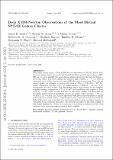| dc.contributor.author | Mantz, Adam B | |
| dc.contributor.author | Allen, Steven W | |
| dc.contributor.author | Morris, R Glenn | |
| dc.contributor.author | Canning, Rebecca EA | |
| dc.contributor.author | Bayliss, Matthew | |
| dc.contributor.author | Bleem, Lindsey E | |
| dc.contributor.author | Floyd, Benjamin T | |
| dc.contributor.author | McDonald, Michael A. | |
| dc.date.accessioned | 2022-07-21T21:56:51Z | |
| dc.date.available | 2021-09-20T18:21:54Z | |
| dc.date.available | 2022-07-21T21:56:51Z | |
| dc.date.issued | 2020 | |
| dc.identifier.uri | https://hdl.handle.net/1721.1/132340.2 | |
| dc.description.abstract | <jats:title>ABSTRACT</jats:title>
<jats:p>We present results from a 577 ks XMM–Newton observation of SPT-CL J0459–4947, the most distant cluster detected in the South Pole Telescope 2500 square degree (SPT-SZ) survey, and currently the most distant cluster discovered through its Sunyaev–Zel’dovich effect. The data confirm the cluster’s high redshift, z = 1.71 ± 0.02, in agreement with earlier, less precise optical/IR photometric estimates. From the gas density profile, we estimate a characteristic mass of $M_{500}=(1.8\pm 0.2)\times 10^{14}\, {\rm M}_{\odot }$; cluster emission is detected above the background to a radius of $\sim \!2.2\, r_{500}$, or approximately the virial radius. The intracluster gas is characterized by an emission-weighted average temperature of 7.2 ± 0.3 keV and metallicity with respect to Solar of $Z/\, Z_{\odot }=0.37\pm 0.08$. For the first time at such high redshift, this deep data set provides a measurement of metallicity outside the cluster centre; at radii $r\gt 0.3\, r_{500}$, we find $Z/\, Z_{\odot }=0.33\pm 0.17$ in good agreement with precise measurements at similar radii in the most nearby clusters, supporting an early enrichment scenario in which the bulk of the cluster gas is enriched to a universal metallicity prior to cluster formation, with little to no evolution thereafter. The leverage provided by the high redshift of this cluster tightens by a factor of 2 constraints on evolving metallicity models, when combined with previous measurements at lower redshifts.</jats:p> | en_US |
| dc.language.iso | en | |
| dc.publisher | Oxford University Press (OUP) | en_US |
| dc.relation.isversionof | 10.1093/MNRAS/STAA1581 | en_US |
| dc.rights | Creative Commons Attribution-Noncommercial-Share Alike | en_US |
| dc.rights.uri | http://creativecommons.org/licenses/by-nc-sa/4.0/ | en_US |
| dc.source | arXiv | en_US |
| dc.title | Deep XMM–Newton observations of the most distant SPT-SZ galaxy cluster | en_US |
| dc.type | Article | en_US |
| dc.contributor.department | MIT Kavli Institute for Astrophysics and Space Research | en_US |
| dc.contributor.department | Massachusetts Institute of Technology. Department of Physics | en_US |
| dc.relation.journal | Monthly Notices of the Royal Astronomical Society | en_US |
| dc.eprint.version | Author's final manuscript | en_US |
| dc.type.uri | http://purl.org/eprint/type/JournalArticle | en_US |
| eprint.status | http://purl.org/eprint/status/PeerReviewed | en_US |
| dc.date.updated | 2020-11-04T17:39:06Z | |
| dspace.orderedauthors | Mantz, AB; Allen, SW; Morris, RG; Canning, REA; Bayliss, M; Bleem, LE; Floyd, BT; McDonald, M | en_US |
| dspace.date.submission | 2020-11-04T17:39:12Z | |
| mit.journal.volume | 496 | en_US |
| mit.journal.issue | 2 | en_US |
| mit.license | OPEN_ACCESS_POLICY | |
| mit.metadata.status | Publication Information Needed | en_US |
